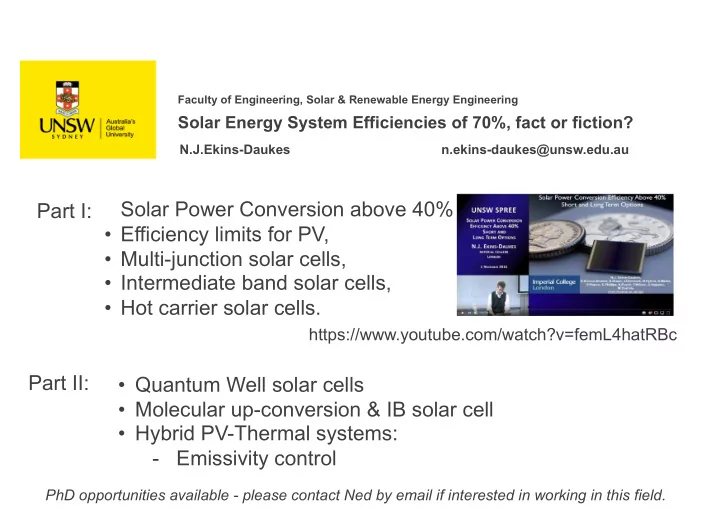

Faculty of Engineering, Solar & Renewable Energy Engineering Solar Energy System Efficiencies of 70%, fact or fiction? N.J.Ekins-Daukes n.ekins-daukes@unsw.edu.au Solar Power Conversion above 40% Part I: • Efficiency limits for PV, • Multi-junction solar cells, • Intermediate band solar cells, • Hot carrier solar cells. https://www.youtube.com/watch?v=femL4hatRBc Part II: • Quantum Well solar cells • Molecular up-conversion & IB solar cell • Hybrid PV-Thermal systems: - Emissivity control PhD opportunities available - please contact Ned by email if interested in working in this field.
An early influence:
Quantum Well Solar Cell Carrier capture Keith Barnham Bulk K. Barnham & G.Duggan. Journal of Applied Physics (1990) vol. 67 (7) pp. 3490
Quantum Well Solar Cell K.Barnham et al., Appl.Phys.Lett. 59, 135 (1991)
GaAs/InGaAs MQW Solar Cells EBIC 25keV GaAs Control 19% J.Barnes et al., J. Appl. Phys, 79, 7775-7779 (1996) 10 MQW 17% Mazzer et al. Mat Sci Eng B-Solid (1996) vol. 42 pp. 43-51 23 MQW 12%
Strain-Balanced Multi-Junction Solar Cell Dr John Roberts, University of Sheffield.
GaAsP / InGaAs Strain-Balance Cell EBIC 10kV N. J. Ekins-Daukes, et. al., Appl. Phys. Lett., 75, p 4195, (1999) & Cryst Growth Des, vol. 2, no. 4, pp. 287–292, (2002).
Record Single Junction Quantum Well Solar Cell Peak efficiency: 28.3% K.Barnham, M.Mazzer, J.S. Roberts, T.Tibbits, D.Bushnell and Quantasol team … (2009) J.Nelson & N.Ekins-Daukes “Clean Electricity from Photovoltaics”, 2nd Ed. Imperial College Press 2014.
Dual (InGaP/InGaAsP)/(GaAsP/InGaAs)/Ge MQW 3J solar cell B. Browne, 9th Interna/onal Conference on Concentrator Photovoltaic Systems: CPV-9, 2013, vol. 1556, no. 1, pp. 3–5.
Proc. IEEE, 1993
Equivalent Circuit for a Shockley-Queisser Solar Cell W. Shockley and H.J. Queisser. J Appl Phys (1961) vol. 32 (3) pp. 510
An Equivalent Circuit for the Intermediate Band Solar Cell Martin Green, Third Generation Photovoltaics, Springer Verlag, 2003
Signature of an intermediate band material: N. J. Ekins-Daukes, C. B. Honsberg, and M. Yamaguchi, IEEE Photovoltaic Specialists Conference, 2005. pp. 49–54.
Photochemical up-conversion Emitter Porphyrin sensitiser PdPh 4 TBP\ Rubrene Baluschev et al. New J. Phys. (2008) vol. 10 (1) pp. 013007 T. F. Schulze Energy Environ. Sci. (2015) vol. 8, no. 1, pp. 103
Molecular intermediate ‘band’ solar cell MIBSC Emitter only N. J. Ekins-Daukes and T. Schmidt, Applied Physics Letters (2008) vol. 93, no. 6, pp. 063507 C. Simpson, Phys Chem Chem Phys (2015) vol. 17, no. 38, pp. 24826
PV Technologies on a TRL scale Technology readiness level: c-Si MJ - CPV (46%) IB & Spectral Conversion https://en.wikipedia.org/wiki/ Technology_readiness_level Efficiency 0% 40% 87%
The Virtu PV-Thermal Module • Up to 80% system efficiency measured at 2 pilot installations • Large supermarket in Southern England • Hotel in Malta. http://www.nakedenergy.co.uk
Application for low-grade heat Low Convective emissivity Radiative coating vacuum Fox, D. B., et al., Energy & Environmental Science 4 (2011) 3731-3740
What is the emissivity of c-Si PV ? Highly doped textured c-Si wafer (Calculated) c-Si Solar Cell Sopori, B., et al., (Measured) Journal of Elec. Materi. Santbergen, R., et al., 28 (1999) 1385-1389 Sol. Mat. 92 (2008) 432-444 Un-doped polished c-Si wafer (Calculated) Zhu, L., et al., Optica 1 (2014) 32-38. Solar flux Thermal emission (6000K) (370K) Wavelength 19
Measuring Emissivity Emissivity of an unencapsulated silicon solar cell Emissivity (E) = Absorptivity (A) = 1 – Reflectance (R) – Transmittance (T) *Wikipedia: https://en.wikipedia.org/wiki/Integrating_sphere 20
Calculating Emissivity Optical Modelling of silicon solar cells Light Range of dimensions: • Wafer thickness ~ 200 µm • Texture features ~ 4 µm • Coatings ~ 50 nm Green MA, 1995, Silicon solar cells: advanced principles and practice Simulation Method? • Ray tracing / Monte-Carlo – computationally costly • Full wave optical – computationally prohibitive 21
Calculating Emissivity Optical Modelling of silicon solar cells Wave-Optical Matrix Formalism – (OPTOS*) B D C Ray Tracing 22 *Tucher, N., et al., Optics Express 23 (2015) A1720-A1734 *Eisenlohr, J., et al., Optics Express 23 (2015) A502-A518
The origin of emissivity Emissivity of an unencapsulated silicon solar cell emissivity Emissivity/absorptivity Riverola, A., et. al., Mid-infrared emissivity of crystalline silicon solar cells, submitted 23
The origin of emissivity Emissivity of an unencapsulated silicon solar cell 24 Riverola, A., et. al., Mid-infrared emissivity of crystalline silicon solar cells, submitted
The origin of emissivity Emissivity of an encapsulated silicon solar cell Rubin, M., Solar Energy Materials 12 (1985) 275-288 Riverola, A., et. al., Mid-infrared emissivity of crystalline silicon solar cells, submitted 25
Controlling emissivity Indium Tin Oxide (ITO) coatings for emissivity suppression Emissivity Suppression Electrical Losses ~0.5% electrical efficiency loss 26
PV-T Collector Results thermal efficiency gain ~ 10 percentage points electrical efficiency loss ~ 0.5 percentage points 27
Conclusion: Solar Energy System Efficiencies of 70%, fact or fiction?
Acknowledgements: Imperial College London: Chemical Engineering Physics Diego Alex Mellor Ilaria Alonso-Alvarez Guarracino Christos Markides Tom Wilson Phoebe Pearce Alba Ramos Cabal also Alberto Riverola, Daniel Chemisana, University of Lleida, Spain and Douglas Paul, Lourdes Ferre Lin, University of Glasgow, U.K..
Recommend
More recommend